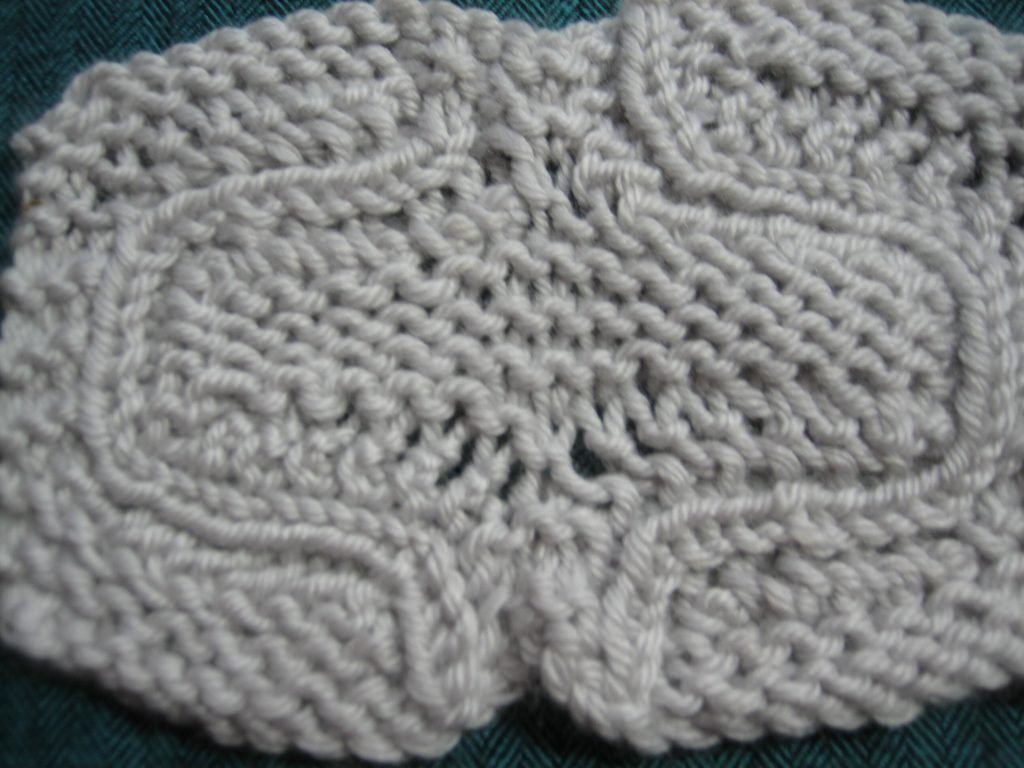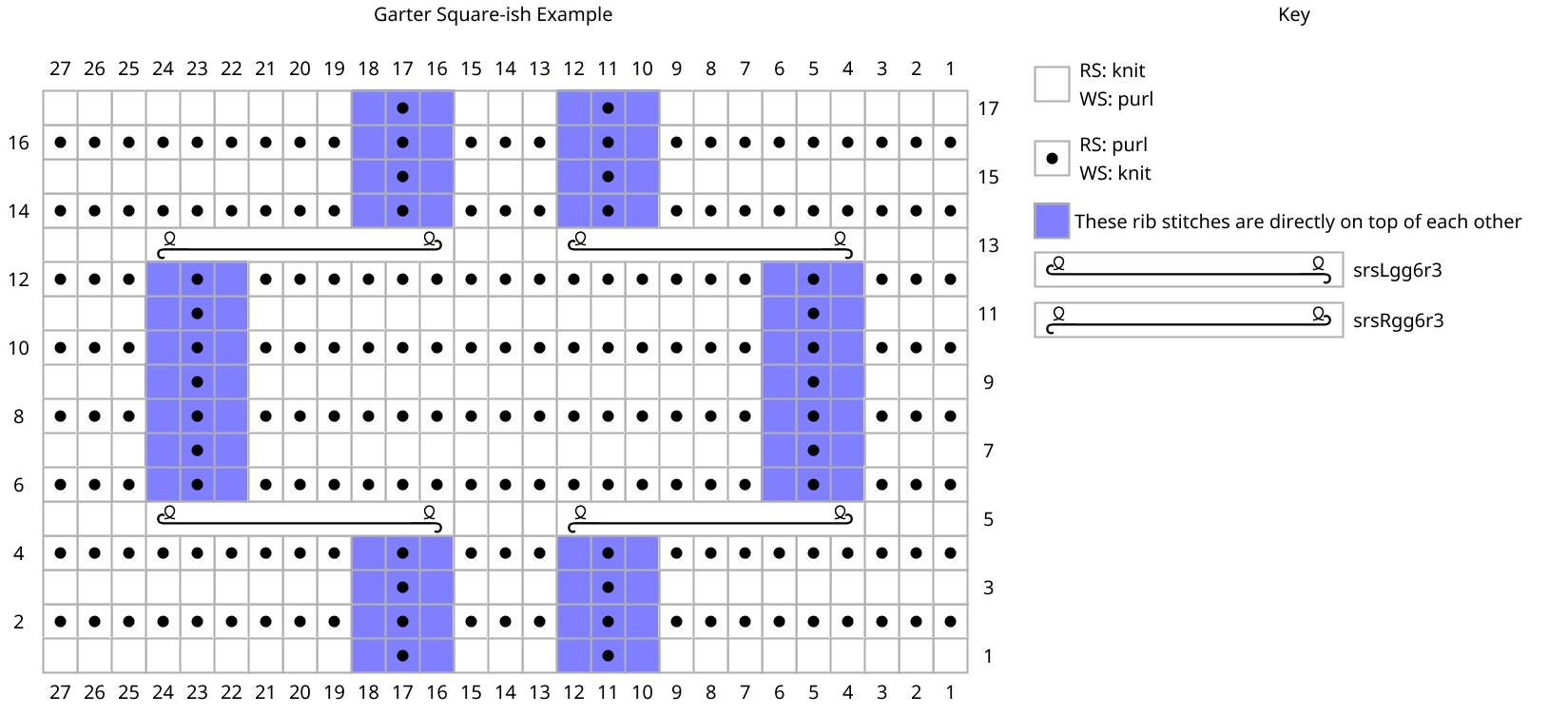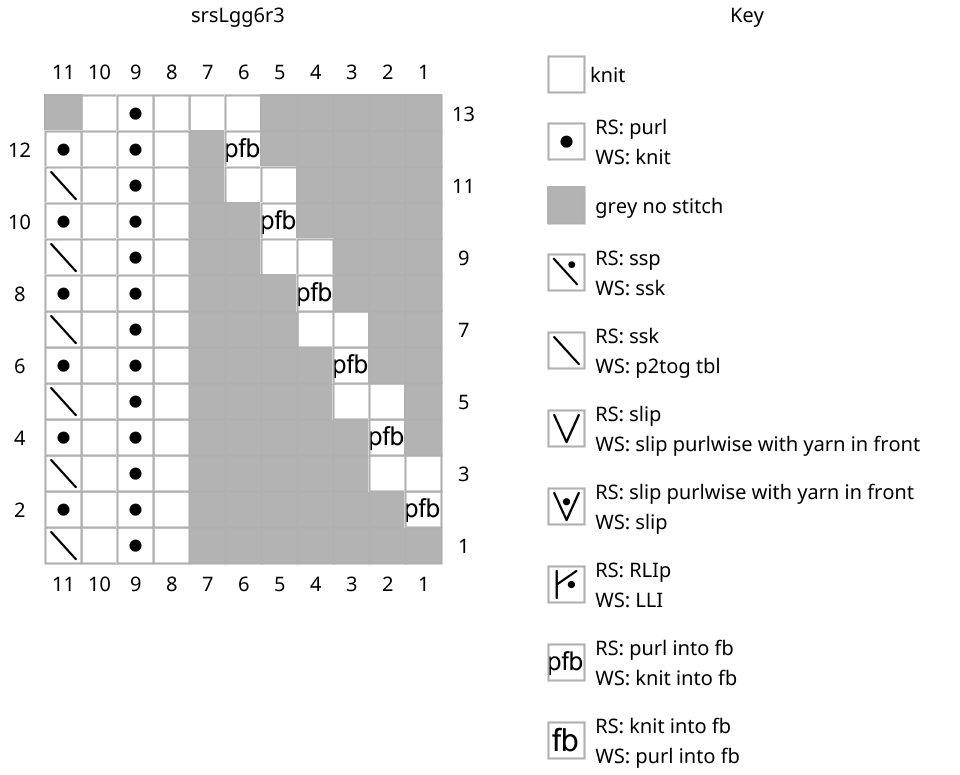I introduced the Short Row Slide idea in this post, it’s a way of making a column of ribbing look as if it were sliding horizontally. The individual slides are all explained with written instructions and charts in the (soon to be released) patterns, but I wanted to explain how and why I dealt with each field.


The abbreviation code works like this:

a. L or R for left or right leaning slide for the bordering rib between the ogees as it rises
through the fabric.
b. In this part of the abbreviation, the field of fabric is listed as you come to them in your knitting. This is where knitting and English confuse each other; in the code the fields are listed left to right, but you come to them in your knitting from right to left. I read them out loud to myself, then follow that order on my needles when I’m proofing my pattern, when I’m knitting, I just read the stitches. The types of fabric fields you will encounter
are:
- g for garter
- P for reverse stockinette field
- K for stockinette field
- kpk for K1, p1, k1 ribbing
- pkp for P1, k1, p1 ribbing
c. the number of stitches that are sliding horizontally.
To explain how the slides work, I decided to go from the same field to the same field, but then I needed 3 rib stitches so that they would contrast with the garter stitch, not the pairs of ribbed stitches I used in Al-Andalus, Octans and Habib; where I was going from stockinette to reverse stockinette. Going garter field to garter field, I wanted a knit column on each edge of the ribbing. With the slides I needed for the Octans shawl, and these blog examples, I added r# for the number of stitches in the rib. In this case, r3 for the three ribbed stitches that are sliding, so a right slide is called srsRgg6r3.

Garter Square-ish Example
Row 1 (RS): K10, p1, k5, p1, k10. (27 sts)
Row 2 (WS): K9, p1, k1, p1, k3, p1, k1, p1, k9.
Rows 3 and 4: Repeat rows 1 and 2.
Row 5: K3, srsRgg6r3, k3, srsLgg6r3, k3.
Rows 6: K3, p1, k1, p1, k15, p1, k1, p1, k3.
Row 7: K4, p1, k17, p1, k4.
Rows 8 – 11: Repeat rows 6 – 7.
Row 12: Repeat row 6.
Row 13: K3, srsLgg6r3, k3, srsRgg6r3, k3.
Row 14: K9, p1, k1, p1, k3, p1, k1, p1, k9.
Row 15: K10, p1, k5, p1, k10.
Rows 16 – 17: Repeat rows 14 – 15.

srsRgg6r4
Row 1 (RS): K7, p1, k1, kfb. (11 sts)
Row 2 (WS): K2, p1, k1, p1, k2tog. (6 sts)
Row 3: K2, p1, k1, kfb.
Rows 4 – 11: Repeat rows 2 – 3.
Row 12: Repeat row 2.
Row 13: K2, p1, k7. (10 sts)
While the left and right slides are reverses of each other, in a left slide, you work right up until the ribbing to begin. You do the same thing in a right slide, but the main chart symbol covers up the stitches you are working to get there, so they are included in the mini-chart. It’s a little weird to look at the instructions and have one be so much wider than the other, but that’s how it worked out.

srsLgg6r3
Row 1 (RS): K1, p1, k1, ssk1. (4 sts)
Row 2 (WS): (K1, p1) x 2, kfb. (6 sts)
Row 3: K3, p1, k1, ssk1.
Rows 4 – 11: Repeat rows 2 – 3.
Row 12: Repeat row 2.
Row 13: K3, p1, k1. (5 sts)
Because I wanted the slide to gook garter-stitchy, I didn’t slip any stitches at the turns. I got away with it because garter draws in horizontally. The holes in the bases of the “tiles” in Al-Andalus and Habibi are from the tension from increasing from 1 stitch to 3 after and immediate decrease from 3 to 1, and the bottom stitches on the tiles are also a bit loose.
My test knitters (and Susanne Visch who TE’ed Al-Andalus and Habibi) pointed out how weird it is that the short row slides don’t have working and resting rows, so the chart for the left slide includes pfb, because it’s a WS row, but the written instructions call for a kfb. I tried to make the slides have working and resting rows, but for stockinette and reversed stockinette, I couldn’t line up the slipped stitches closing the short row hole that way, and I saw no point in having some slides with resting rows, and others without.
Coming soon I’ll blog about stockinette, reverse stockinette and ribbed stitches, but the swatches have to dry first. I forgot to mention, short row slides MUST BE BLOCKED. And your yarn needs some wool in it to hold the blocking, the samples were knit in a wool/acrylic blend.
My Patterns Andalus and Habibi use these techniques.
